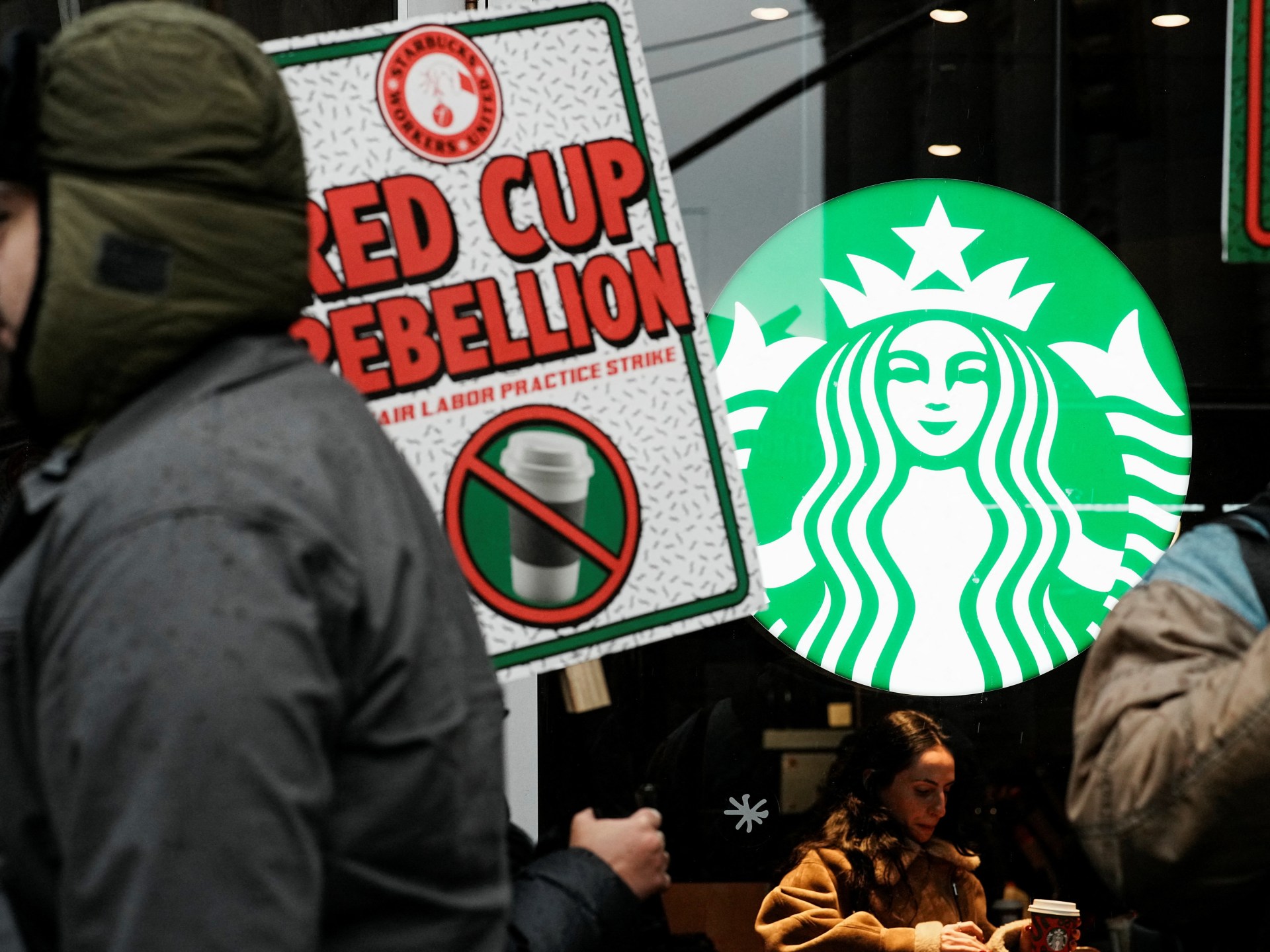More than a thousand unionized Starbucks baristas in more than 40 cities across the United States have walked off the job as negotiations between the company and the union, Starbucks Workers United, have stalled.
Workers at 65 stores began an open strike Thursday to coincide with the Seattle, Washington-based coffee shop chain’s Red Cup Day sales event, when customers who order a holiday-themed drink can get a free reusable cup with their purchase.
Recommended stories
4 List of itemsEnd of list
Events typically bring more traffic to Starbucks stores.
The coffeeshop chain, which has more than 18,000 stores in the US and Canada, says the walkout has had limited impact.
More stores may join the strike soon. Starbucks Workers United US represents about 550 stores. Collectively, the strike could be the largest in the coffeeshop chain’s history.
Stores in Seattle, New York, Philadelphia, Dallas, Austin and Portland will join the work stoppage, it said. Some locations were already closed for the day, a union spokesperson told reporters on a media call.
In an Instagram post on Thursday, the union urged customers not to shop at any Starbucks location “today and beyond” ahead of the nationwide rally that begins at 4 p.m. local time for each location.
The union has filed more than 1,000 charges with the National Labor Relations Board for alleged unfair labor practices, such as unionizing baristas, and last week, voted to authorize a strike if a contract is not finalized by Nov. 13.
Starbucks said it pays an average wage of $19 an hour and offers benefits including healthcare, parental leave and tuition for online classes at Arizona State University to employees who work at least 20 hours a week.
The union said the starting wage is $15.25 an hour in about 33 states, and the average barista works less than 20 hours per week.
Talks between the union and the company dragged on for about eight months in 2024, but broke down in December, after workers went on strike during the main holiday period.
“Unfortunately, it’s not uncommon to use stall tactics in collective bargaining, like we’re seeing at Starbucks. But the situation and the strike vote also show that long-term grassroots organizing empowers workers. There’s strength in numbers,” shared Jennifer Abruzzo, former general counsel, former president of the National Labor Relations Board under the US Labor Relations Board. With Al Jazeera.
History of strikes
Starting in 2021, Starbucks workers have gone on strike several times over the years. Workers in Buffalo, New York, became the first unionized store and then launched a nationwide movement, which now represents four percent of Starbucks cafe workers, or about 9,500 people.
In 2022, workers at about 100 stores went on strike and in December 2024Workers walked off the job in stalled negotiations at 300 stores. Negotiations resumed earlier this year, but the two sides have yet to reach an agreement.
In April of this year, the union voted to reject a Starbucks proposal that guaranteed at least a two percent annual raise, because it did not replace economic benefits such as healthcare or immediate pay raises.

“Even though thousands of Starbucks baristas voted to join collective bargaining a few years ago, the company has manipulated the situation to prevent an agreement,” Sharon Block, executive director of the Center for Labor and the Just Economy at Harvard Law School, said in comments to Al Jazeera.
“Baristas are strong. The strength of the strike vote shows that baristas are not giving up. They are demanding fair treatment from the company.”
executive pressure
The strike comes as Starbucks is led by CEO Brian Nichol Closes hundreds Underperforming stores this year, including the Unionized flagship Seattle location, while trimming corporate roles to control costs.
Nichol, who previously led Chipotle for six years, has focused on improving service times and the in-store experience in the US to revive demand for the beverage as sales have been flat or negative for the past seven quarters.
When Nicoll took over as CEO in September last year, he said he was committed to dialogue.
However, Lynn Fox, the union’s international president, told reporters that things changed when Nicole took the helm.
“One year into Nicole’s tenure, negotiations have backtracked last year after steady progress and good faith negotiations,” Fox said.
According to the AFL-CIO’s Executive Paywatch Tracker, in 2024, Niccol’s compensation package was more than $95m, 6,666 times the salary of the average employee. According to the Institute for Policy Studies’ Executive Access Report, the S&P 500 shows the largest gap in CEO-to-worker pay.
Niccol’s pay, however, is largely based on the performance of Starbucks stock, with $90m coming from the value of stock awards. Since Nicholl took over the company in September 2024, Starbucks’ share price has fallen about 6 percent.
On Wall Street, Starbucks stock was down 0.9 percent in midday trading.

